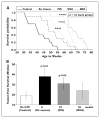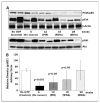Effective prostate cancer chemopreventive intervention with green tea polyphenols in the TRAMP model depends on the stage of the disease
- PMID: 19276266
- PMCID: PMC2991083
- DOI: 10.1158/1078-0432.CCR-08-2332
Effective prostate cancer chemopreventive intervention with green tea polyphenols in the TRAMP model depends on the stage of the disease
Abstract
Purpose: We have shown previously that oral feeding of green tea polyphenols (GTP) to transgenic adenocarcinoma of the mouse prostate mice in a purely chemopreventive setting significantly inhibits prostate cancer development. To translate this to a human situation, the present study was designed to identify the stage of prostate cancer that is most vulnerable to chemopreventive intervention by GTP.
Experimental design: GTP infusion (0.1% in drinking water) to transgenic adenocarcinoma of the mouse prostate was initiated at ages representing different stage of the disease: (a) 6 weeks (group 1, normal prostate), (b) 12 weeks (group 2, prostatic intraepithelial neoplasia), (c) 18 weeks (group 3, well-differentiated adenocarcinoma), and (b) 28 weeks (group 4, moderately differentiated adenocarcinoma). At age 32 weeks, subsets of animals were evaluated by magnetic resonance imaging, ultrasound, and prostate weight and for serum insulin-like growth factor (IGF)-I/IGF binding protein-3 and IGF signaling.
Results: Tumor-free survival was extended to 38 weeks (P < 0.001) in group 1, 31 weeks (P < 0.01) in group 2, and 24 weeks (P < 0.05) in group 3 compared with 19 weeks in water-fed controls. Median life expectancy was 68 weeks in group 1, 63 weeks in group 2, 56 weeks in group 3, and 51 weeks in group 4 compared with 42 weeks in the control mice. IGF-I and its downstream targets including phosphatidylinositol 3-kinase, pAkt, and phosphorylated extracellular signal-regulated kinase were significantly inhibited only when intervention was initiated early when prostatic intraepithelial neoplasia lesions were common.
Conclusions: Our studies indicate that chemopreventive potential of GTP decreases with advancing stage of the disease and underscore the need to design appropriate chemoprevention clinical trails.
Conflict of interest statement
No potential conflicts of interest were disclosed.
Figures






References
-
- Syed DN, Khan N, Afaq F, Mukhtar H. Chemoprevention of prostate cancer through dietary agents: progress and promise. Cancer Epidemiol Biomarkers Prev. 2007;16:2193–203. - PubMed
-
- Adhami VM, Mukhtar H. Anti-oxidants from green tea and pomegranate for chemoprevention of prostate cancer. Mol Biotechnol. 2007;37:52–7. - PubMed
-
- Boyle P, Severi G. Epidemiology of prostate cancer chemoprevention. Eur Urol. 1999;35:370–6. - PubMed
-
- Hsing AW, Tsao L, Devesa SS. International trends and patterns of prostate cancer incidence and mortality. Int J Cancer. 2000;85:60–7. - PubMed
-
- Peto J. Cancer epidemiology in the last century and the next decade. Nature. 2001;411:390–5. - PubMed
Publication types
MeSH terms
Substances
Grants and funding
LinkOut - more resources
Full Text Sources
Medical

